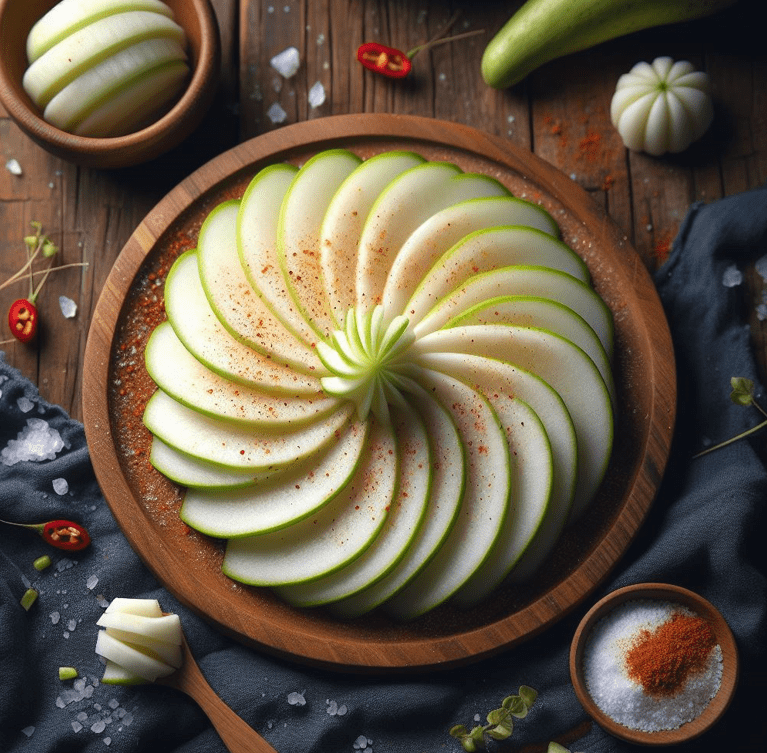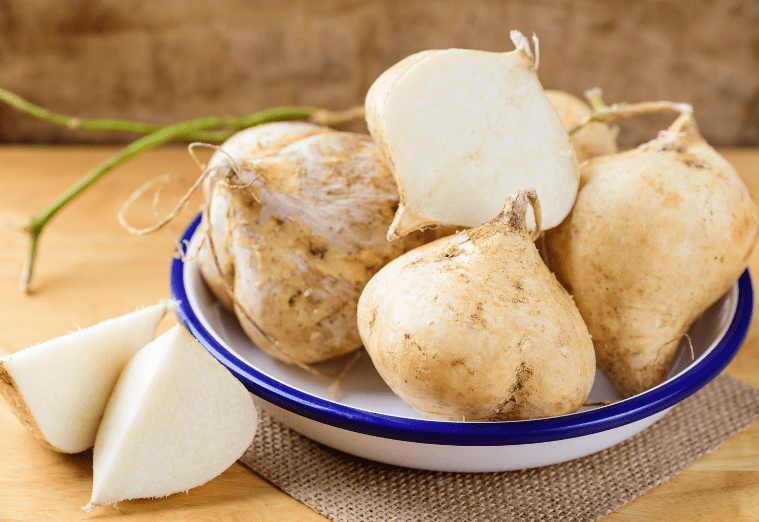
Jicama pronounced “HI-ka-ma,” is a starchy, slightly sweet, and crunchy root vegetable native to Mexico. It is often known as Mexican yam or water chestnut due to its appearance and taste. Jicama is a delicious and nutritious food that is low in calories and fiber, vitamin C, calcium, and potassium. It also has various health benefits, including aiding digestion, boosting immunity, and lowering blood pressure.
How to Choose a Fresh Jicama
Appearance:
- Jicama should be firm and free of any cracks, blemishes, or soft spots.
- It should be light yellow or cream-colored with a smooth, slightly textured skin.
- Avoid jicama that is wrinkled, discolored, or has sprouted roots.
Size and Shape:
- Jicama typically ranges in size from 3 to 6 inches in diameter with a pear or acorn shape.
- The larger the jicama, the tougher and less flavorful it will be.
Weight:
- A good rule of thumb is to choose a jicama that feels heavy for its size.
- This indicates that it is fresh and has a high water content.
Smell:
- Jicama should have a fresh and slightly sweet smell.
- Avoid jicama that has an off-putting odor.
How to Store Jicama
Store unpeeled jicama in a cool, dark, dry place away from direct sunlight. A refrigerator is the best place to store jicama, lasting up to two months. However, if you do not have room in the refrigerator, you can store it in a cool, dry place for up to two weeks. Once peeled, jicama can be stored in the refrigerator for up to two or three days.
How to Prepare Jicama
-
Peel the jicama: Use a sharp knife to peel off the tough outer skin carefully. The peel is edible, but it is not very palatable.
-
Cut the jicama: Once peeled, cut the jicama into desired shapes and sizes. You can slice it thinly for salads or slaws, or chop it into cubes or matchsticks for stir-fries or roasting.
How to Eat Jicama Fresh
Jicama is a versatile vegetable that can be eaten raw or cooked. It is a great addition to salads, slaws, salsas, and crudités platters. It can also be a crunchy snack with lime juice and chile powder.
How to Cook Jicama
Jicama can be roasted, fried, steamed, or added to soups, stews, and stir-fries. Roasting brings out its sweetness and makes it nice and crispy. Frying makes it more tender and flavorful. Steaming helps to preserve its nutrients and texture.

Recipes with Jicama
Here are some recipes that feature jicama:
-
Jicama Fries: Slice jicama thinly and fry in oil until crispy. Season with salt and any other spices you like.
-
Jicama Tacos: Fill corn tortillas with jicama, shredded cabbage, avocado, salsa, and your favorite taco toppings.
-
Jicama and Mango Salad: Combine jicama, mango, red onion, and cilantro. Toss with lime juice, olive oil, and salt.
Health and Nutrition Benefits of Jicama
Jicama is a nutrient-rich vegetable that offers a variety of health benefits. Here are some of the most notable benefits:
-
Fiber: Jicama is a good source of fiber, which helps to promote digestive health, regulate blood sugar levels, and promote satiety.
-
Vitamin C: Jicama is packed with vitamin C, an essential nutrient that boosts the immune system, protects against cell damage, and aids in collagen production.
-
Potassium: Jicama is a good source of potassium, a mineral that helps regulate blood pressure and fluid balance.
-
Antioxidants: Jicama contains antioxidants that help protect cells from damage caused by free radicals.
-
Weight Management: Jicama is low in calories and high in fiber, making it a good choice for people trying to lose weight or maintain a healthy weight.
Conclusion
Jicama is a delicious and nutritious vegetable that can be enjoyed in a variety of ways. It is a good source of fiber, vitamins, minerals, and antioxidants. Jicama is also low in calories and fat, making it a healthy addition to any diet.


























